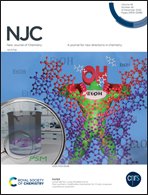A highly sensitive and selective “on–off–on” fluorescent aptamer sensor based on tea residue carbon quantum dots for the detection of sulfadiazine in honey
Abstract
A sulfadiazine (SDZ) aptamer sensor based on carboxylated tea residue carbon quantum dots (C-TCDs) was studied to detect SDZ residues in honey. C-TCDs were synthesized by a hydrothermal method. The C-TCD labeled SDZ aptamer was used as a recognition probe, and the C-TCD labeled cDNA was used as a complementary chain to construct a fluorescent aptamer sensor. The fluorescence intensity of the constructed sensor has a good linear relationship with the concentration of SDZ in the detection range of 0–80 ng mL−1 (y = 12.857x + 828.721, R2 = 0.99768), and the detection limit is 0.95 ng mL−1. The sensor constructed using this method has good specificity and excellent anti-interference ability for ions that often appear in honey. The accuracy of the fluorescent sensor is high, the spiked recovery is 93.2–102.4%, and the standard deviation is 4.5–9.7%. These results show that this fluorescent sensor based on the C-TCD modified SDZ aptamer can detect SDZ residues in honey sensitively, accurately and selectively.



 Please wait while we load your content...
Please wait while we load your content...